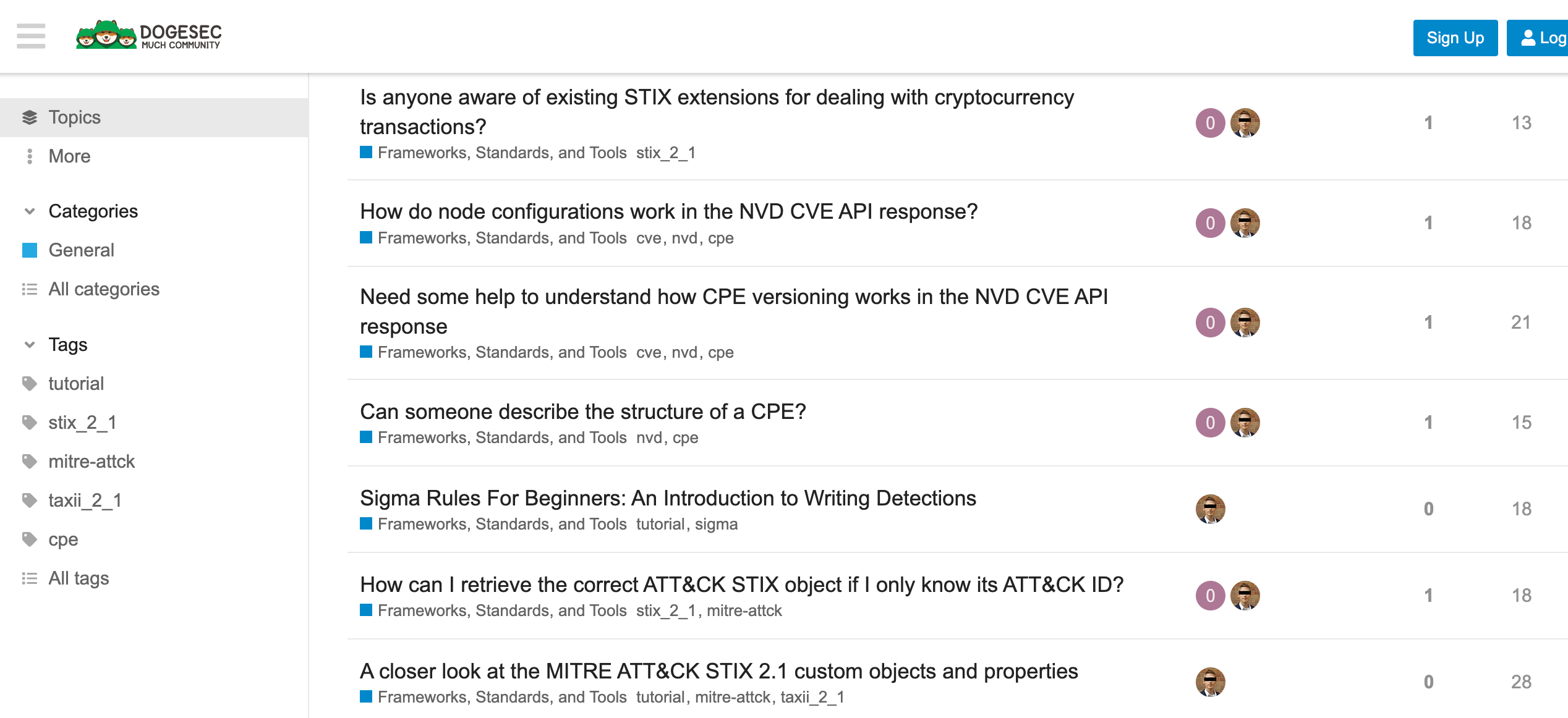If you are reading this blog post via a 3rd party source it is very likely that many parts of it will not render correctly. Please view the post on dogesec.com for the full interactive viewing experience.
If you prefer, you can also access the markdown of this post here.
tl;dr
We wanted to distribute STIX 2.1 objects to our community using TAXII. We built a TAXII server coupled with a storage layer to do this. It is called Arango TAXII Server. This post describes how you can get started with it.
Optional pre-reading
If you’re new to TAXII, start by reading these tutorials in our community forum, they will make this post much easier to read:
- TAXII 2.1 Server Core Concepts (using the Medallion TAXII server)
- TAXII 2.1 Client Core Concepts (using the OASIS TAXII client)
Install Arango TAXII Server
If you’re following along with this post I am going to assume you’ve installed an ArangoDB instance locally and your Arango TAXII Server .env file looks like this;
# ARANGO
ARANGODB='http://127.0.0.1:8529/'
# CELERY
CELERY_BROKER_CONNECTION_RETRY_ON_STARTUP=1
# POSTGRES
POSTGRES_DB=postgres
POSTGRES_USER=postgres
POSTGRES_PASSWORD=postgres
# TAXII SERVER
SERVER_BASE_URL='http://127.0.0.1:8000/'
SERVER_TITLE='Arango TAXII Server'
SERVER_DESCRIPTION='https://github.com/muchdogesec/arango_taxii_server/'
SERVER_MAX_CONTENT_LENGTH=10485760
SERVER_EMAIL='[email protected]'
SERVER_SUPPORT='https://community.dogesec.com/'
Once you’ve started the Docker container, as per the documentation linked above, you can access the Swagger UI for the API in a browser at: http://127.0.0.1:8000/api/schema/swagger-ui/

Now, before I walk through using Arango TAXII Server, let me start by seeding our server with a Database and some Collections.
Seeding
Arango TAXII Server considers every database in ArangoDB as a TAXII root.
To create a new Database in ArangoDB:
- Log in to the web interface (http://127.0.0.1:8529/), as root
- Select
_system - Select
Databases - Select
Add new Database - Create your Database making sure the name ends in
_database(e.g. I usedtaxii_root_demo_databasein the video)
Now for the Collections…
ArangoDB uses stix2arango as middle-ware.
As such Arango TAXII Server expects a pair of Collections (one vertex, one edge), named with the suffixes *_vertex_collection and *_edge_collection.
You can use stix2arango to create these collections (recommended).
Alternatively you can create them in the ArangoDB UI (make sure to create them in the correct database):
- Log in to the web interface (http://127.0.0.1:8529/), as root
- Select the Database you want to add the collections to (e.g.
taxii_root_demo_database) - Select
Collections - Select
Add new Collection - Create your Document Collection making sure the name ends in
_vertex_collection(e.g. I useddemo_vertex_collectionin the video) - Create your Edge Collection making sure the name ends in
_edge_collection(e.g. I useddemo_edge_collectionin the video)
User and authentication
Arango TAXII Server uses the ArangoDB user and permissions models.
Arango TAXII Server will only show Databases and Collections a user has either Read or Read/Write permissions to.
In order to use POST and DELETE TAXII endpoints, a user must have Read/Write permissions for the relevant Collection.
Here is a quick demonstration on how to manage user permissions in ArangoDB;
- Log in to the web interface (http://127.0.0.1:8529/), as root
- Select
_system - Select
Users - Select the user you want to change permissions for
- Select
Permissions - Assign correct permissions to Databases and/or Collections for selected user
Using Arango TAXII Server
Now I have created a Database, some Collections, and have assigned user permissions I can start using the Arango TAXII Server.
To authenticate against the API, a user must pass their ArangoDB user credentials (base64 encoded) in the header of each request using basic auth as follows;
Authorization: Basic <credentials in base64>
If you want to use the Swagger UI, you can enter your credentials as follows;

To get all TAXII API Roots (aka ArangoDB Databases) my user is authorised to see:
curl -X 'GET' \
'http://127.0.0.1:8000/api/taxii2/' \
-H 'accept: application/json' \
-H 'Authorization: Basic REVOKED'
{
"title": "Arango TAXII Server",
"description": "https://github.com/muchdogesec/arango_taxii_server/",
"contact": "[email protected]",
"api_roots": [
"http://127.0.0.1:8000/api/taxii2/_system/",
"http://127.0.0.1:8000/api/taxii2/cti_database/",
"http://127.0.0.1:8000/api/taxii2/test_db_13_database/",
"http://127.0.0.1:8000/api/taxii2/test_db_1_database/",
"http://127.0.0.1:8000/api/taxii2/taxii_root_demo_database/"
]
}
You can see the taxii_root_demo_database API Root I created in the video above, along with some other Collections already on my server.
I can get info about this API Root as follows
curl -X 'GET' \
'http://127.0.0.1:8000/api/taxii2/taxii_root_demo_database/' \
-H 'accept: application/json' \
-H 'Authorization: Basic REVOKED'
{
"max_content_length": 10485760,
"title": "taxii_root_demo_database",
"versions": [
"application/stix+json;version=2.1"
]
}
Note, Arango TAXII Server only supports STIX 2.1 Objects.
Let’s see what Collections this API Root holds:
curl -X 'GET' \
'http://127.0.0.1:8000/api/taxii2/taxii_root_demo_database/collections/' \
-H 'accept: application/json' \
-H 'Authorization: Basic REVOKED'
{
"collections": [
{
"id": "demo",
"title": "demo",
"description": "vertex+edge",
"can_read": true,
"can_write": true,
"media_types": [
"application/stix+json;version=2.1"
]
}
]
}
You can see only one collection is returned, even though I created two. Remember, that’s because Arango TAXII Server will consider pairs of edge and vertex collections will first be joined before being exposed to the user. So above, demo considers the ArangoDB Collections demo_vertex_collection and demo_edge_collection.
You’ll see my user can both read and write to this Collection. As noted, wether as user can read/write, read or even see a Collection is defined under the permissions of the ArangoDB user.
If there were more collection pairs, and the authenticated user could read them, you’d see them listed in this response too.
To see the objects this Collection holds…
curl -X 'GET' \
'http://127.0.0.1:8000/api/taxii2/taxii_root_demo_database/collections/demo/objects/' \
-H 'accept: application/json' \
-H 'Authorization: Basic REVOKED'
{
"more": false,
"next": null,
"objects": []
}
The response is empty because I have not added any Objects to this Collection yet.
Let me do that now.
Here I am adding a Threat Actor (taken from the STIX 2.1 examples):
curl -X 'POST' \
'http://127.0.0.1:8000/api/taxii2/taxii_root_demo_database/collections/demo/objects/' \
-H 'accept: application/json' \
-H 'Authorization: Basic REVOKED' \
-H 'Content-Type: application/json' \
-d '{
"objects": [{"type":"threat-actor","spec_version":"2.1","id":"threat-actor--dfaa8d77-07e2-4e28-b2c8-92e9f7b04428","created":"2014-11-19T23:39:03.893Z","modified":"2014-11-19T23:39:03.893Z","name":"Disco Team Threat Actor Group","description":"This organized threat actor group operates to create profit from all types of crime.","threat_actor_types":["crime-syndicate"],"aliases":["Equipo del Discoteca"],"roles":["agent"],"goals":["Steal Credit Card Information"],"sophistication":"expert","resource_level":"organization","primary_motivation":"personal-gain"}]
}'
{
"id": "c3c73600-2dd4-4dc1-aece-0b73eb959094",
"status": "pending",
"total_count": 1,
"success_count": 0,
"successes": [],
"failure_count": 0,
"failures": [],
"pending_count": 1,
"pendings": [
{
"message": null,
"version": "2024-05-22 13:44:29.664616+00:00",
"id": "threat-actor--dfaa8d77-07e2-4e28-b2c8-92e9f7b04428"
}
],
"request_timestamp": "2024-05-22T13:44:29.664616Z"
}
This request returns a status response for the POST request to add objects.
We can check the status of the request at any time as follows;
curl -X 'GET' \
'http://127.0.0.1:8000/api/taxii2/taxii_root_demo_database/status/c3c73600-2dd4-4dc1-aece-0b73eb959094/' \
-H 'accept: application/json' \
-H 'Authorization: Basic REVOKED'
{
"id": "c3c73600-2dd4-4dc1-aece-0b73eb959094",
"status": "complete",
"total_count": 1,
"success_count": 1,
"successes": [
{
"message": null,
"version": "2024-05-22 13:54:15.089657+00:00",
"id": "threat-actor--dfaa8d77-07e2-4e28-b2c8-92e9f7b04428"
}
],
"failure_count": 0,
"failures": [],
"pending_count": 0,
"pendings": [],
"request_timestamp": "2024-05-22T13:54:15.089657Z"
}
The object has now moved from pending to complete.
If we now retrieve it:
curl -X 'GET' \
'http://127.0.0.1:8000/api/taxii2/taxii_root_demo_database/collections/demo/objects/threat-actor--dfaa8d77-07e2-4e28-b2c8-92e9f7b04428/?limit=10' \
-H 'accept: application/json' \
-H 'Authorization: Basic REVOKED'
{
"more": false,
"next": null,
"objects": [
{
"aliases": [
"Equipo del Discoteca"
],
"created": "2014-11-19T23:39:03.893Z",
"description": "This organized threat actor group operates to create profit from all types of crime.",
"goals": [
"Steal Credit Card Information"
],
"id": "threat-actor--dfaa8d77-07e2-4e28-b2c8-92e9f7b04428",
"modified": "2014-11-19T23:39:03.893Z",
"name": "Disco Team Threat Actor Group",
"primary_motivation": "personal-gain",
"resource_level": "organization",
"roles": [
"agent"
],
"sophistication": "expert",
"spec_version": "2.1",
"threat_actor_types": [
"crime-syndicate"
],
"type": "threat-actor"
},
{
"aliases": [
"Equipo del Discoteca"
],
"created": "2014-11-19T23:39:03.893Z",
"description": "This organized threat actor group operates to create profit from all types of crime.",
"goals": [
"Steal Credit Card Information"
],
"id": "threat-actor--dfaa8d77-07e2-4e28-b2c8-92e9f7b04428",
"modified": "2014-11-19T23:39:03.893Z",
"name": "Disco Team Threat Actor Group",
"primary_motivation": "personal-gain",
"resource_level": "organization",
"roles": [
"agent"
],
"sophistication": "expert",
"spec_version": "2.1",
"threat_actor_types": [
"crime-syndicate"
],
"type": "threat-actor"
}
]
}
Because Arango TAXII Server uses stix2arango as middleware, it can also handle updates of objects.
Lets add the same object, with an updated title (NEW TITLE) and modified time (2020-01-01T00:00:00.000Z)
curl -X 'POST' \
'http://127.0.0.1:8000/api/taxii2/taxii_root_demo_database/collections/demo/objects/' \
-H 'accept: application/json' \
-H 'Authorization: Basic REVOKED' \
-H 'Content-Type: application/json' \
-d '{
"objects": [{"type":"threat-actor","spec_version":"2.1","id":"threat-actor--dfaa8d77-07e2-4e28-b2c8-92e9f7b04428","created":"2014-11-19T23:39:03.893Z","modified":"2020-01-01T00:00:00.000Z","name":"NEW TITLE","description":"This organized threat actor group operates to create profit from all types of crime.","threat_actor_types":["crime-syndicate"],"aliases":["Equipo del Discoteca"],"roles":["agent"],"goals":["Steal Credit Card Information"],"sophistication":"expert","resource_level":"organization","primary_motivation":"personal-gain"}]
}'
{
"id": "59684531-e636-4b6e-b209-453b0c68df47",
"status": "pending",
"total_count": 1,
"success_count": 0,
"successes": [],
"failure_count": 0,
"failures": [],
"pending_count": 1,
"pendings": [
{
"message": null,
"version": "2024-05-22 13:59:31.898585+00:00",
"id": "threat-actor--dfaa8d77-07e2-4e28-b2c8-92e9f7b04428"
}
],
"request_timestamp": "2024-05-22T13:59:31.898585Z"
}
If I now check the version endpoint;
curl -X 'GET' \
'http://127.0.0.1:8000/api/taxii2/taxii_root_demo_database/collections/demo/objects/threat-actor--dfaa8d77-07e2-4e28-b2c8-92e9f7b04428/versions/' \
-H 'accept: application/json' \
-H 'Authorization: Basic REVOKED'
{
"more": false,
"next": null,
"versions": [
"2014-11-19T23:39:03.893Z",
"2020-01-01T00:00:00.000Z"
]
}
We can see both versions in the database.
Using the parameters available on the object endpoint, I can select the desired version of this object. By default, the TAXII server will always return the latest version of the object (in this case 2020-01-01T00:00:00.000Z).
And that’s 10 minutes!
Our Arango TAXII Server implements the entire TAXII specification.
In this post I have only covered some of the TAXII endpoints and have not shown you how to use the filtering and paging parameters available on them.
My suggestion would be to keep playing with Arango TAXII Server using the Swagger UI interface. You’ll quickly get familiar with how it works and what you can do.
Of course, if you just want to connect a TAXII Client to your Arango TAXII Server install you don’t need to worry about any of this – the Client will handle it all for you!
Discuss this post
Head on over to the DOGESEC community to discuss this post.

Never miss an update
Sign up to receive new articles in your inbox as they published.
